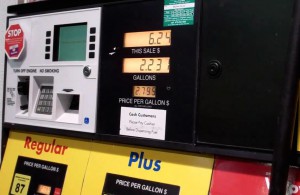
As sales of full-size trucks, like the F-150, continue to tick upwards, fuel efficiency averages for new vehicles slides downward.
As the sales of trucks and utility vehicles continue to surge, the fuel-economy of new vehicles sold in the U.S. continues to drop, according to a monthly study by the University of Michigan.
In fact researchers at the University of Michigan Transportation Research Institute found the fuel economy of new vehicles sold in the U.S. as rated by the federal Environmental Protection Agency fell for the second month in a row. The average fuel economy, or window-sticker values, of cars, light trucks, vans and SUVs purchased in September was 25.2 mpg, down 0.1 mpg from August.
“This decline likely reflects the decreased price of gasoline in September, and the consequent increased sales of pickup trucks, SUVs and crossovers,” said Michael Sivak, a research professor at UMTRI.
Overall, fuel economy is down 0.6 mpg from the peak reached in August 2014, but up 5.1 mpg from October 2007—the first full month of monitoring by Sivak and colleague Brandon Schoettle.
In addition to average fuel economy, Sivak and Schoettle issued a monthly update of their national Eco-Driving Index, which estimates the average monthly emissions generated by an individual U.S. driver, Sivak said.
During July, the EDI remained at 0.82 (the lower the value, the better) for the third straight month. The index currently shows emissions of greenhouse gases per driver of newly purchased vehicles are down 18 percent, overall, since October 2007. EDI reached its best level (0.78) in August 2014.
Meanwhile, gasoline prices remain relatively stable, with AAA reporting the national average price for regular unleaded gasoline holding at $2.29 per gallon this week. The average price is up by fractions of a penny compared to one week ago, but has moved lower for 43 of the past 49 days, providing drivers with a savings of 12 cents per gallon month-over-month, AAA reported.
(Toyota debuting three concepts and a painfully cute robot at Tokyo. For more, Click Here.)
Significant yearly discounts remain with drivers saving $1.01 per gallon on average, largely attributed to cheaper crude oil and ample gasoline supplies, AAA said.
AAA also noted that retail averages have declined 51 cents per gallon since reaching the 2015 peak price of $2.80 per gallon on June 15. The national average tends to move lower during the autumn and winter months due to seasonal declines in both driving and gasoline demand, and pump prices have fallen during the month of October for three years in a row.
(Click Here to see what Honda is bringing to this year’s Tokyo Motor Show.)
Despite refineries going offline to conduct scheduled maintenance, there should still be more than enough gasoline to meet demand because people tend to drive less this time of year. Barring any major disruptions in supply, the national average is expected to move lower by the end of the year, and for the first time since 2009, could fall below the $2 per gallon benchmark.
Drivers in every state are paying an average price at the pump below $3 per gallon for the first time since 2009. Averages on the West Coast remain among some of the highest in the nation, with California at $2.94 unseating Alaska at $2.91 as the nation’s most expensive market for retail gasoline.
(Nissan’s Dayz concept is a mobile social media device. Click Here to check it out.)
The global supply of oil continues to exceed demand on global energy markets. Saudi Arabia, the world’s largest exporter of petroleum and the swing member of the Organization of Petroleum Exporting Countries, has announced plans to further cut prices to Asia in an effort to protect its market share. Russia is reportedly ready to enter talks with OPEC and other producing countries about possible reductions in output.


Has anyone reading this column looked at gasoline prices in suburban Chicago lately?
It’s been rising almost daily for about a week or two. Currently, it’s averaging about $2.59.9 in the western suburbs… many places closer to “The City” are much higher.
Stories about sub-$2.00 gasoline read like articles from the 1970’s.
Gene, the challenge with writing fuel price stories is that there are endless exceptions. As regular readers know, I travel fairly constantly, and I am constantly amazed at the disparity of fuel prices, not just by state but sometimes within a small community. I recently saw a station in Monterey, CA charging $4.60 a gallon while another a block away wanted $3.49. I also saw prices in the San Francisco area running from $2.80 to mid-$3.00. A colleague riding with me last week was regaling me with stories of how low (below $2) he was paying. My home in Michigan has been bouncing all over the place. There are endless reasons, and I wouldn’t rule out the greed factor. But prices really have fallen, on the overall.
Paul E.
People generally buy what makes them happy unless they are being blackmailed by OPEC or the oil industry Cartel. Then they might make a different purchasing decision.
Thanks Gene, I thought I was the only one feeling the Western Suburb pain. Was up at one of our plants in WI and it was pretty much the same, $2.599, a few stations $2.559. Funny things is whether you were right off I94/41 or a ways in you were paying the same, and it didn’t matter the station. I can tell you I haven’t both petrol in Chicago in 20 years. And I’m too far to hop to Indiana any more + their prices are basically the same. I can hop a couple towns over to Plano area and get 20 ~ 30 cents/gal less.
But Paul, it seems as though whenever you guys post these stories our prices magically go up. I give you grief but it’s all in fun – I know you’re not setting prices or are you…lol